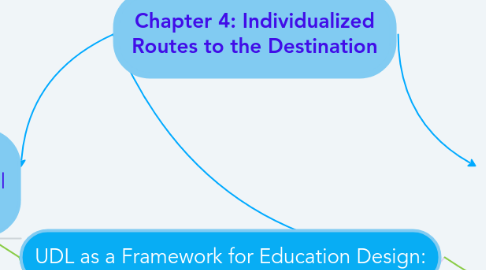Chapter 4: Individualized Routes to the Destination
by Emily Scharer

1. UDL as a Framework for Education Design:
2. Learner Capacities
3. Previous Goal: Master the skill or knowledge
4. Learning depends on context for the learner
5. Allows for positive learning outcomes and a well designed curriculum
6. Must understand the context of learning
7. This idea is flawed because:
8. How to use learner capacity effectively:
9. Usually the individual and the context of learning and the environment are considered separate
10. Usually the learner has strengths and weaknesses and those are considered to not ever change
11. This means that it will also be used to understand that the learner will act and perform different depending on the environment, context, and circumstances even though they have specific strengths, weaknesses, abilities, or inabilities.
12. This means that you use the context to understand how the learner will use their "internal capacity" to achieve their goals
13. References
14. Meyer, A., Rose, D., Gordon, D., (2014). Universal Design for Learning: Theory and Practice. Wakefield, MA: CAST.
15. Towards a Critical Theory of Disability in Social Work. (2005). Retrieved from http://www1.uwindsor.ca/criticalsocialwork/towards-a-critical-theory-of-disability-in-social-work
16. Usually is made up of two groups: gifted and students with learning disabilties
17. Vary over time and different situations
18. Learner Variability
19. The Goal for Education Now: become experts at learning
20. Predict variability creates flexibility
21. Allows for individualized instruction and customization
22. Usually is individualized to the extreme
23. This means that you use the variability to predict what the learners will do and how they will learn best.
24. This idea is flawed because:
25. This means it will also be used to use the predictions to maintain flexible learning options to achieve success for most learners
26. How to use variability effectively:


